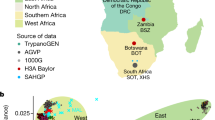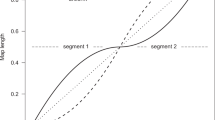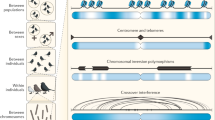Abstract
Recombination, together with mutation, gives rise to genetic variation in populations. Here we leverage the recent mixture of people of African and European ancestry in the Americas to build a genetic map measuring the probability of crossing over at each position in the genome, based on about 2.1 million crossovers in 30,000 unrelated African Americans. At intervals of more than three megabases it is nearly identical to a map built in Europeans. At finer scales it differs significantly, and we identify about 2,500 recombination hotspots that are active in people of West African ancestry but nearly inactive in Europeans. The probability of a crossover at these hotspots is almost fully controlled by the alleles an individual carries at PRDM9 (P value < 10−245). We identify a 17-base-pair DNA sequence motif that is enriched in these hotspots, and is an excellent match to the predicted binding target of PRDM9 alleles common in West Africans and rare in Europeans. Sites of this motif are predicted to be risk loci for disease-causing genomic rearrangements in individuals carrying these alleles. More generally, this map provides a resource for research in human genetic variation and evolution.
This is a preview of subscription content, access via your institution
Access options
Subscribe to this journal
Receive 51 print issues and online access
$199.00 per year
only $3.90 per issue
Buy this article
- Purchase on Springer Link
- Instant access to full article PDF
Prices may be subject to local taxes which are calculated during checkout



Similar content being viewed by others
References
Jeffreys, A. J., Kauppi, L. & Neumann, R. Intensely punctate meiotic recombination in the class II region of the major histocompatibility complex. Nature Genet. 29, 217–222 (2001)
McVean, G. A. et al. The fine-scale structure of recombination rate variation in the human genome. Science 304, 581–584 (2004)
Myers, S., Bottolo, L., Freeman, C., McVean, G. & Donnelly, P. A fine-scale map of recombination rates and hotspots across the human genome. Science 310, 321–324 (2005)
Kong, A. et al. Fine-scale recombination rate differences between sexes, populations and individuals. Nature 467, 1099–1103 (2010)
Kong, A. et al. A high-resolution recombination map of the human genome. Nature Genet. 31, 241–247 (2002)
Matise, T. C. et al. A second-generation combined linkage-physical map of the human genome. Genome Res. 17, 1783–1786 (2007)
Weitkamp, L. R. Proceedings: population differences in meiotic recombination frequency between loci on chromosome 1. Cytogenet. Cell Genet. 13, 179–182 (1974)
Jorgenson, E. et al. Ethnicity and human genetic linkage maps. Am. J. Hum. Genet. 76, 276–290 (2005)
Berg, I. L. et al. PRDM9 variation strongly influences recombination hot-spot activity and meiotic instability in humans. Nature Genet. 42, 859–863 (2010)
The 1000 Genomes Project Consortium. A map of human genome variation from population-scale sequencing. Nature 467, 1061–1073 (2010)
Baudat, F. et al. PRDM9 is a major determinant of meiotic recombination hotspots in humans and mice. Science 327, 836–840 (2010)
Myers, S. et al. Drive against hotspot motifs in primates implicates the PRDM9 gene in meiotic recombination. Science 327, 876–879 (2010)
Parvanov, E. D., Petkov, P. M. & Paigen, K. Prdm9 controls activation of mammalian recombination hotspots. Science 327, 835 (2010)
Smith, M. W. et al. A high-density admixture map for disease gene discovery in African Americans. Am. J. Hum. Genet. 74, 1001–1013 (2004)
Price, A. L. et al. Sensitive detection of chromosomal segments of distinct ancestry in admixed populations. PLoS Genet. 5, e1000519 (2009)
Sankararaman, S., Sridhar, S., Kimmel, G. & Halperin, E. Estimating local ancestry in admixed populations. Am. J. Hum. Genet. 82, 290–303 (2008)
Patterson, N. et al. Methods for high-density admixture mapping of disease genes. Am. J. Hum. Genet. 74, 979–1000 (2004)
The International HapMap Consortium. A second generation human haplotype map of over 3.1 million SNPs. Nature 449, 851–861 (2007)
Freedman, M. L. et al. Admixture mapping identifies 8q24 as a prostate cancer risk locus in African-American men. Proc. Natl Acad. Sci. USA 103, 14068–14073 (2006)
Coop, G., Wen, X., Ober, C., Pritchard, J. K. & Przeworski, M. High-resolution mapping of crossovers reveals extensive variation in fine-scale recombination patterns among humans. Science 319, 1395–1398 (2008)
Myers, S., Freeman, C., Auton, A., Donnelly, P. & McVean, G. A common sequence motif associated with recombination hotspots and genome instability in humans. Nature Genet. 40, 1124–1129 (2008)
Kong, A. et al. Sequence variants in the RNF212 gene associate with genome-wide recombination rate. Science 319, 1398–1401 (2008)
Reich, D. E. et al. Linkage disequilibrium in the human genome. Nature 411, 199–204 (2001)
Raedt, T. D. et al. Conservation of hotspots for recombination in low-copy repeats associated with the NF1 microdeletion. Nature Genet. 38, 1419–1423 (2006)
Griffiths, R. C. & Tavaré, S. Unrooted genealogical tree probabilities in the infinitely-many-sites model. Math. Biosci. 127, 77–98 (1995)
Patterson, N., Price, A. L. & Reich, D. Population structure and eigenanalysis. PLoS Genet. 2, e190 (2006)
International HapMap 3 Consortium. Integrating common and rare genetic variation in diverse human populations. Nature 467, 52–58 (2010)
Li, Y., Willer, C. J., Ding, J., Scheet, P. & Abecasis, G. R. MaCH: using sequence and genotype data to estimate haplotypes and unobserved genotypes. Genet. Epidemiol. 34, 816–834 (2010)
Devlin, B. & Roeder, K. Genomic control for association studies. Biometrics 55, 997–1004 (1999)
Acknowledgements
We are grateful to the participants who donated DNA samples, to D. Altshuler, J. Buard, K. Bryc, J. Kovacs, B. de Massy, G. McVean, B. Pasaniuc and S. Sankararaman for conversations and critiques, and to A. Auton for facilitating analysis of the 1000 Genomes Project data. Analysis was supported by the Wellcome Trust and NIH grants HL084107 and GM091332. CARe was supported by a contract from the National Heart, Lung and Blood Institute (HHSN268200960009C) to create a phenotype and genotype database for dissemination to the biomedical research community. Eight parent studies contributed phenotypic data and DNA samples through the Broad Institute (N01-HC-65226): the Atherosclerosis Risk in Communities study (ARIC), the Cleveland Family Study (CFS), the Coronary Artery Risk Development in Young Adults study (CARDIA), the Jackson Heart Study (JHS), the Multi-Ethnic Study of Atherosclerosis (MESA) study, the Cardiovascular Health Study (CHS), the Framingham Heart Study (FHS) and the Sleep Heart Health Study (SHHS). Support for CARe also came from the individual research institutions, investigators, field staff and study participants. Individual funding information is available at http://public.nhlbi.nih.gov/GeneticsGenomics/home/care.aspx. All genome-wide genotyping of samples from the Children’s Hospital of Pennsylvania (CHOP) was supported by an Institutional Development Award to the Center for Applied Genomics from the Children’s Hospital of Philadelphia, a research award from the Landenberger Foundation and the Cotswold Foundation. We thank all study participants and the staff at the Center for Applied Genomics for performing the genotyping. The African American Breast Cancer Consortium (AABCC) was supported by a DoD Breast Cancer Research Program Era of Hope Scholar Award to C.A.H. and the Norris Foundation, and by grants to the component studies: MEC (CA63464, CA54281); CARE (HD33175); WCHS (CA100598, DAMD 170100334, Breast Cancer Research Foundation); SFBC (CA77305, DAMD 17966071); CBCS (CA58223, ES10126), PLCO (NCI Intramural Research Program); NHBS (CA100374); WFBC (R01-CA73629); and CPS-II (the American Cancer Society). The African American Prostate Cancer Consortium (AAPCC) was supported by grants CA63464, CA54281, CA1326792, CA148085 and HG004726, and by grants to the component studies: PLCO (NCI Intramural Research Program), LAAPC (Cancer Research Fund 99-00524V-10258), both MEC and LAAPC (PC35139, DP000807); MDA (CA68578, CA140388, ES007784, DAMD W81XWH0710645); GECAP (ES011126); CaP Genes (CA88164); IPCG (W81XWH0710122); DCPC (GM08016, DAMD W81XWH0710203, DAMD W81XWH0610066); and SCCS (CA092447, CA68485). The African American Lung Cancer Consortium (AALCC) was supported by grants CA060691, CA87895, PC35145 and CA22453, CA68578, CA140388, ES007784, ES06717, CA55769, CA127219, CA1116460S1, CA1116460, CA121197, CA141716, CA121197S2, CPRIT RP100443, CA148127, DAMD W81XWH0710645, University Cancer Foundation, Duncan Family institute, Center for Community, Implementation and Dissemination Research Core, and by grants to the component studies: PLCO and the Maryland Studies (NCI Intramural Research Program), LAAPC (Cancer Research Fund 99-00524V-10258), and both MEC and LAAPC (PC35139, DP000807).
Author information
Authors and Affiliations
Contributions
D.R. and S.R.M. conceived the study. A.G.H., A.T., N.P., Y.S., N.R., C.D.P., G.K.C., K.W., S.G.B., D.R. and S.R.M. performed analyses. N.R. performed the experimental work (genotyping of polymorphisms at PRDM9). A.G.H., N.P., J.N.H., B.E.H., H.A.T. Jr, A.L.P., H.H., S.J.C., C.A.H., J.G.W., D.R. and S.R.M. coordinated the study. A.G.H., D.R. and S.R.M. wrote the paper. N.R., C.D.P., G.K.C., K.W., S.G.B., S.R., J.N.H., B.E.H., H.A.T. Jr, H.H., S.J.C., C.A.H., J.G.W., D.R. and all the alphabetically listed authors contributed to sample collection and generation of SNP array data. All authors contributed to revision and review of the manuscript.
Corresponding author
Ethics declarations
Competing interests
The authors declare no competing financial interests.
Additional information
Crossover rate estimates for the AA map can be found at http://www.well.ox.ac.uk/~anjali/AAmap/. We also provide estimates of uncertainty for the map based on samples from the MCMC. Association testing results for each SNP are available from the authors on request.
Supplementary information
Supplementary Information
The file contains Supplementary Notes 1-6, Supplementary Tables 1-2 and Supplementary Figures 1-11 with legends. (PDF 2875 kb)
Rights and permissions
About this article
Cite this article
Hinch, A., Tandon, A., Patterson, N. et al. The landscape of recombination in African Americans. Nature 476, 170–175 (2011). https://doi.org/10.1038/nature10336
Received:
Accepted:
Published:
Issue Date:
DOI: https://doi.org/10.1038/nature10336
This article is cited by
-
Algorithmic fairness in artificial intelligence for medicine and healthcare
Nature Biomedical Engineering (2023)
-
The recombination landscape of the Khoe-San likely represents the upper limits of recombination divergence in humans
Genome Biology (2022)
-
A genome sequence from a modern human skull over 45,000 years old from Zlatý kůň in Czechia
Nature Ecology & Evolution (2021)
-
Genetic differentiation and intrinsic genomic features explain variation in recombination hotspots among cocoa tree populations
BMC Genomics (2020)
-
Gene-dense autosomal chromosomes show evidence for increased selection
Heredity (2019)
Comments
By submitting a comment you agree to abide by our Terms and Community Guidelines. If you find something abusive or that does not comply with our terms or guidelines please flag it as inappropriate.



